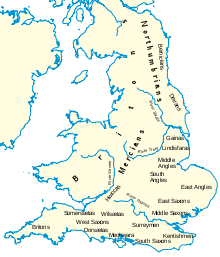- Magic in Anglo-Saxon England
-
Magic in Anglo-Saxon England refers to the belief and practice of magic by the Anglo-Saxons between the fifth and eleventh centuries CE in Early Mediaeval England.
Contents
Background
Following the withdrawal of the Roman armies and administrative government from southern Britain in the early 5th century CE, large swathes of southern and eastern England entered what is now referred to as the Anglo-Saxon period. During this, the populace appeared to adopt the language, customs and religious beliefs of the various tribes, such as the Angles, Saxons and Jutes, living in the area that covers modern Denmark and northern Germany. Many archaeologists and historians have believed that this was due to a widespread migration or invasion of such continental European tribes into Britain, although it has also been suggested that it may have been due to cultural appropriation on behalf of native Britons, who wished to imitate such tribes.[1]
Either way, the Anglo-Saxon populace of England adopted many cultural traits that differed from those in the preceding Iron Age and Romano-British periods. They adopted Old English, a Germanic language that differed markedly from the Celtic and Latin languages previously spoken, whilst they apparently abandoned Christianity, a monotheistic religion devoted to the worship of one God, and instead began following Anglo-Saxon paganism, a polytheistic faith revolving around the veneration of several deities. Differences to people's daily material culture also became apparent, as those living in England ceased living in roundhouses and instead began constructing rectangular timber homes that were like those found in Denmark and northern Germany. Art forms also changed as jewellery began exhibiting the increasing influence of Migration Period Art from continental Europe.
Paganism and Christianity
Anglo-Saxonist scholar Bill Griffiths remarked that it was necessary to understand the development of the pantheon of Anglo-Saxon gods in order to understand "the sort of powers that may lie behind magic ritual."[2] He argued that the Anglo-Saxon pagan religion was "a mass of unorganised popular belief" with various traditions being passed down orally.[3]
Forms of magic
Cunning folk
Various archaeologists, primarily Audrey Meaney and Tania Dickinson, have argued that there were cunning women, or female magical practitioners, during the Anglo-Saxon period.
Stephen Pollington, an expert in Anglo-Saxon England, however commented that "the evidence for 'healing' or 'cunning' men and women in Anglo-Saxon England is sparse, and what little there is remains difficult to interpret."[4]
Witchcraft
The Anglo-Saxons believed that whilst magic could be used for healing and benevolent purposes, it could also be used for malevolent purposes, or witchcraft.
References
Footnotes
- ^ Carver 1998, 100–101.
- ^ Griffiths 2003. p. 17.
- ^ Griffiths 2003. p. 21.
- ^ Pollington 2000. p. 46.
Bibliography
Academic books
- Carver, Martin (1998). Sutton Hoo: Burial Ground of Kings?.
- Griffiths, Bill (2003). Aspects of Anglo-Saxon Magic (Revised edition). Hockwold-cum-Wilton, Norfolk: Anglo-Saxon Books. ISBN 9781898281337.
- Hall, Alaric (2007). Elves in Anglo-Saxon England: Matters of Belief, Health, Gender and Identity. Woodbridge: Boydell Books. ISBN 9781843832942.
- Pollington, Stephen (2000). Leechcraft: Early English Charms, Plantlore and Healing. Hockwold-cum-Wilton, Norfolk: Anglo-Saxon Books. ISBN 9781898281474.
- Wilson, David (1992). Anglo-Saxon Paganism. London and New York: Routledge. ISBN 0415018978.
Academic journal and anthology articles
Categories:- English mythology
- Anglo-Saxon paganism
Wikimedia Foundation. 2010.

